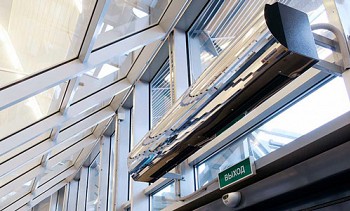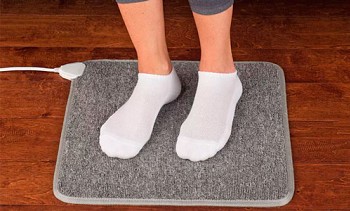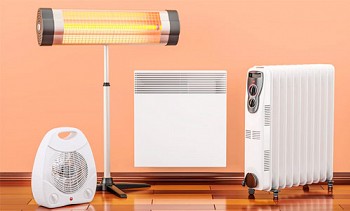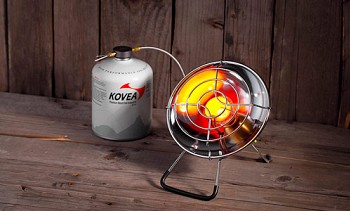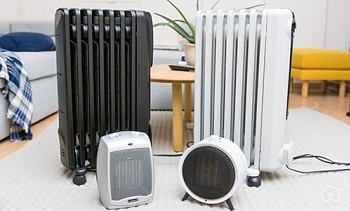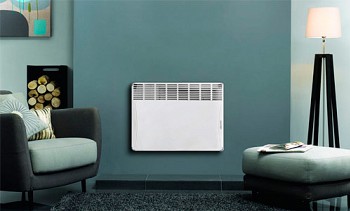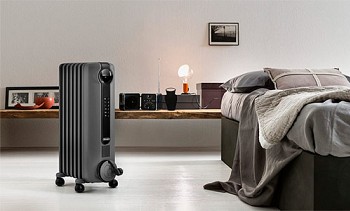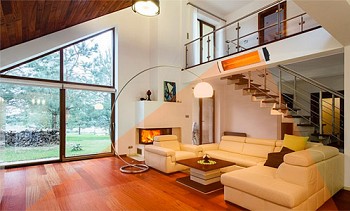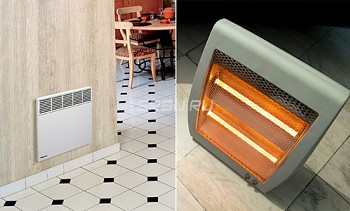How to choose a fan heater for a house or apartment - varieties of their comparison and selection criteria
Fan heaters are one of the most popular heaters. After all, they are the cheapest, and you can buy them during the autumn-winter season in every store that sells household goods. But not everyone knows that these heaters differ not only in design and color - what is hidden inside the case is much more important. After all, it is the “filling” that determines how long the device will last, and how reliably it will work. Consider how to choose a fan heater, having studied all their types, as well as the most important pros and cons of each of them.
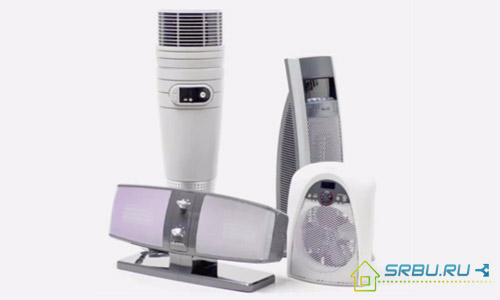
How the fan heater works and what is inside it
Each device of this type has an ordinary fan that moves cold air, fitting it to the heating element. Heated air masses rush into the room. In those models that are stationary, the fan can rotate during operation. Thanks to this, the room heats up more evenly and efficiently.
The fan heater is good in that it can create a comfortable room temperature quickly enough. If the air flow created by the fan has a narrow focus, then you can almost instantly heat the air only where necessary. And in the summer, these heaters easily turn into ordinary fans - this opportunity allows you to save both space in the apartment and money in your pocket.
The design of any fan is quite simple and includes only three details:
- housing;
- heating element;
- fan.
The case must be strong enough, it is made of plastic that can withstand some shocks and shocks. Also in the case there are metal parts. Next, we’ll talk about what types of heating elements are used in heaters of this type, as well as about the design features of the fans used in them.
Comparison of existing types of fan heaters
1. The main thing that fan heaters differ from each other is the type of heating element. It can be spiral type, tubular and ceramic. We will characterize each of them in order to understand which element the best fan heater should be equipped with.
Spiral the element is made, as a rule, of nichrome. It is a thin wire wound on a ceramic base. The open design is unprotected wire coils, and the closed one is the same coils placed in a glass tank inside which there is no coolant. In this case, the wire heats up to 1000 degrees, which is unsafe - after all, when tipping over, an unprotected or poorly protected heating element can cause a fire.
In addition, over time, dust accumulates on the surface of the nichrome wire, which smolders and smells bad when the heater is turned on. Indeed, due to structural features, he is forced to work at high temperatures. Nevertheless, there will never be an open flame in which oxygen can be burned - the spiral is heated by electricity. Therefore, the assertion that this type of heater still burns oxygen is obviously false. This is in the hands of sellers selling other models, here they are spreading rumors.
Glass ceramic the heating element works differently than nichrome. It heats up no more than up to 150 degrees, so such fan heaters for the home are safer.A ceramic part is made in several ways, but the following is most often used: the powder is pressed, and then calcined in an oven at high temperature. In the finished ceramic plate, you can see a large number of tiny holes through which air flows, driven by a fan. In this case, the air masses are heated faster than a nichrome spiral - after all, the area of the ceramic plate is much larger than the area of the spiral or even a tubular PETN.
However, there is a heater with a ceramic element and a significant minus the high cost. So, if you compare them with devices that heat the air with a spiral, it turns out that the latter are cheaper about three times. It should be noted that for the manufacture of heating elements not only glass ceramics are used, but also metal ceramics. They have a similar design and characteristics with spiral elements. The difference is that the nichrome spiral is not made of glass inside the case, but of ceramic. Due to this, fire safety is increased.
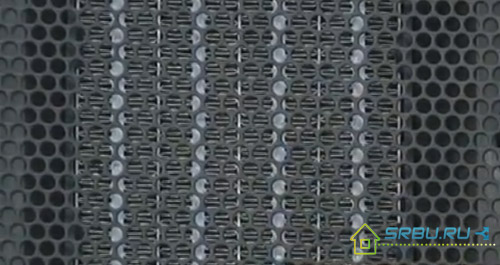
In the photo there is a protective grill of the heater, and under it a glass-ceramic heating element.
Ten (tubular element for heating) - this is a tube made of metal or quartz, inside of which there is a graphite or wire rod. Between them quartz sand is poured, and manganese oxide is also added. As a rule, ten has a quartz filler, the core inside is made of nichrome wire, and quartz sand serves as a filler. It is needed so that the heat received from electricity is distributed evenly over the entire area of the heating element. Thanks to this design, the heater is no longer heated to 1000 degrees, like a spiral element, but only to 500 degrees. Accordingly, the service life will double as well. Unfortunately, the price will rise.
Since PETN is able to repeatedly increase the power of the fan heater, such devices are no longer applicable in everyday life, but in production, garages and utility rooms. There they are called "heat guns", having a power of 2.5 watts or more.
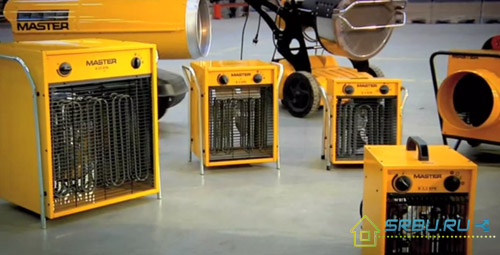
This is how heat guns look.
2. The heaters of the fan heater type differ and the fans built into them, which are made of plastic (for small devices) or metal. There are only two types of fans.
Axial fan usually quite small, but noisy, it has traditional-looking blades. It is placed only on devices that are supposed to be moved.
Tangential fan looks like an oblong cone. On this cone there are twenty or thirty blades parallel to each other. This type of fan has good performance and quiet operation. It moves more air at a time than the axial model. But due to the large length of the cone, such a fan can only fit in heater-columns, which are designed for fixed mounting on the floor or on the wall.
3. That's just the next difference between fan heaters from each other and is their performance - mobile or stationary. The latter, in turn, can be wall or floor.
Portable, or desktop, devices have power from 400 watts to 2 kilowatts, small size and weight. Installing and assembling them is easy, but they have one drawback - noise. Indeed, such devices always have an axial fan.
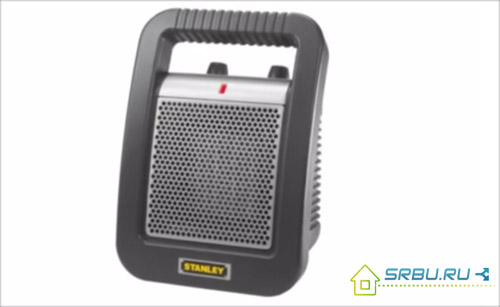
Mobile, portable fan heater.
For fan heaters made in the form of columns, the tangential fan stands upright. The power of these devices can vary from 1.8 to 2.5 kilowatts, and performance is higher than that of mobile devices. Often an automatic rotary device is built into them. These devices can be used not only as fan heaters for apartments, but also as thermal curtains in shops, offices and restaurants. At the same time, they cut off cold air from the street at the entrance to the room.
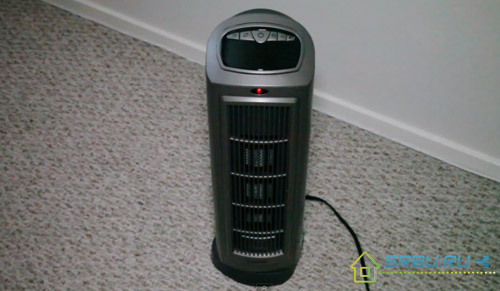
Floor fan heater with a rotating base.
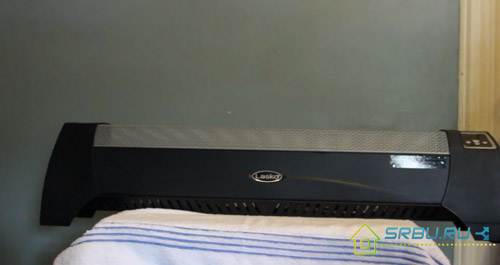
Wall fan heater.
4. The control system for fan heaters can be mechanical or electronic. Some models have a control panel, which creates some additional usability of this device.
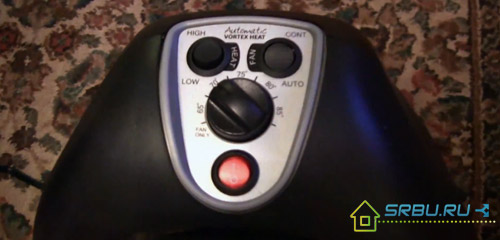
Mechanical control system.
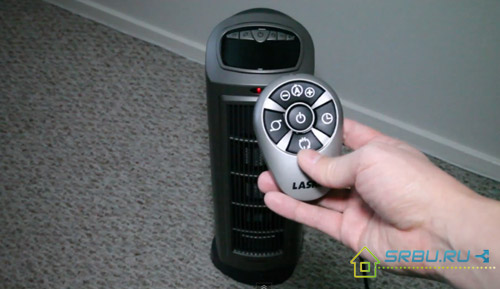
Electronic system with remote control.
Things to consider when choosing a fan heater
Power needed
If the ceiling in the apartment has a height of up to 270 centimeters, then the power of the device is determined as follows: for every 10 square meters, 1 kilowatt is needed. However, it is not worth taking up close - it is better to take the device with a power reserve of 1.3, or even 1.5 times. This is especially useful in frosty winters.
Heating element
Of course, it is best to choose the fan heater that uses a glass ceramic heating element. He will not burn dust, exuding an unpleasant aroma, and is much safer than other types of devices - with a spiral and with a heating element.
Just do not fall for the tricks of sellers. Trying to sell the goods as quickly as possible, they can be a little cunning and say that the heater is equipped with a ceramic heating element. They are only silent at the same time that they do not mean glass ceramics, but metal ceramics, which, as they say, are two big differences. Therefore, a simple tip, before choosing a ceramic fan heater - carefully read the instructions. If the glass-ceramic plate is almost not heated, then the ceramic-metal element is only slightly better than a spiral one.
Operating modes
Number of operating modes heater should ideally be as large as possible. This is convenient - without using a thermostat, you can immediately set the desired temperature, necessary for a feeling of warmth and comfort. However, the maximum possible number of modes is three; in modern models, no more is given.
Additional functions
It is very good if the fan heater has the following functions and devices:
- A rotating base will allow warm air to reach all the far corners of the room;
- A fan that makes little noise — ideally — is tangential;
- Shutdown sensors triggered by tipping and overheating of the device;
- Thermostat;
- The ability to maintain a temperature of plus 5 degrees, almost without spending energy (anti-freeze function or from freezing);
- Housing with splash protection (useful in the bathroom);
- Humidifier and filter to maintain a healthy microclimate;
- Remote Control.
Finally:
Now that we have become familiar with how a fan heater is selected, it's time to list a few simple rules. They will allow you to remain safe and sound both for you and your home, and for a device for heating the room and creating a comfortable temperature in it. So, you need to know quite a bit.
1. Remember: fan heaters do not like to be dropped or dragged using a power cord. It is especially bad when the appliance topples over when turned on.
2. Do not pour liquid over the appliance (even ordinary water) and turn it on where it is too wet.
3. It is necessary to set the fan heater no closer than half a meter from any object.
4. If someone wants beauty and coziness, and he decides to cover the heater with a cloth, it may happen that you have to bitterly regret it. Such actions can lead to overheating of the device, and even to a fire!
Table of technical characteristics and basic criteria for selecting fan heaters
| Parameters | Values | Selection recommendations |
|---|---|---|
| Power mobile Power stationary |
400 to 2000 watts from 1800 to 2500 watts |
At 10 m2 - 1 kilowatt, but it is better to take with a margin of 1.3 - 1.5 kilowatts. |
| Execution | Mobile Stationary. |
+ Easy to carry and put anywhere. + Used silent fans, built-in rotating base. |
| Type of heating element | Spiral; Ceramic: Glass ceramic Cermet Ten. |
It is better to give preference to glass-ceramic. |
| Number of operating modes | Mostly found - 3 modes | The bigger, the better. |
| Fan type | Axial; Tangential. |
Tangential - more silent. |
| Tilt and Overheat Sensors | Availability varies by model | Best if these sensors are in stock. |
| Thermostat | Availability varies by model | Useful if there is a need to maintain a constant temperature. |
| Antifreeze function | Availability varies by model | It may be useful if you need to maintain the temperature of the room + 50C and prevent freezing. |
| Splash protection | Availability varies by model | If you intend to use the appliance in a bathroom or kitchen, availability is important. |
| Humidifier and filter | Availability varies by model | Availability is not critical, but desirable. |
| Remote Control | Availability varies by model | If available, it is more convenient to control the heater. |
Video: Fan Heaters - Comparative Review

